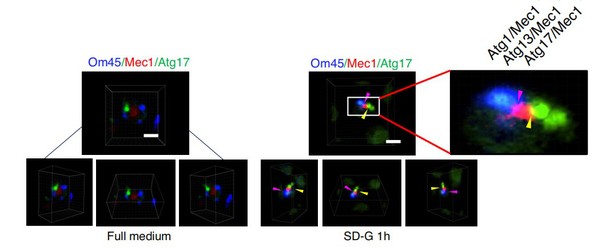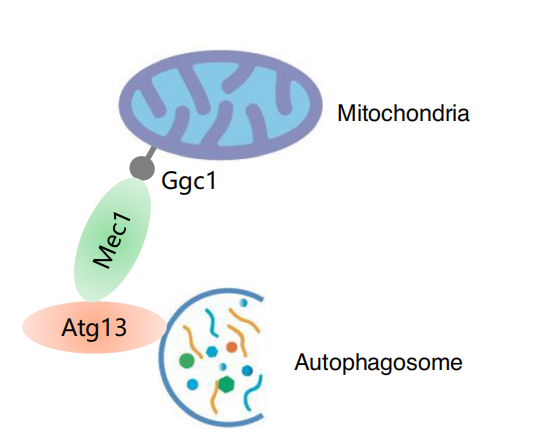New mechanism of glucose starvation-induced autophagy
Substance metabolism and energy metabolism are two basic characteristics of life activities. Autophagy is also regulated by substance and energy metabolismand in turn participates in regulating them. So far, the molecular mechanism of substance metabolism regulating autophagy is relatively clear. Autophagy can be induced by amino acid starvation, nitrogen source starvation, growth factor deprivation, or rapamycin treatment, and a series of signal molecules and degradation substrates have been identified. However, the understanding of the relationship between energy metabolism and autophagy remains at the level of the energy sensor AMPK regulating energy deprivation-induced autophagy through phosphorylation of a substrate protein including ULK1, and we know little about new signaling pathways, genetic heterogeneity involved in energy deprivation-induced autophagy, degradation substrates, and physiological significance for energy-sensitive organs such as the heart, muscles, and especially brain nerve cells, which are most responsive to energy deprivation.
Our previous studies found that the ROS level increases significantly under the glucose starvation condition, which makes the DNA damage sensor Mec1(ATR in mammals) export from the nucleus and recruit to mitochondria in the form of puncta for maintaining aerobic respiration. The aerobic respiration activity was then found to be essential for glucose starvation-induced autophagy. Concurrently, the energy sensor Snf1 (AMPK in mammals) is involved in the maintenance of aerobic respiration activity by phosphorylating Mec1. Finally, phosphorylated Mec1 participates in glucose starvation-induced autophagy by regulating the formation of Atg1 complex. However, it is still unclear that how Mec1 involves in autophagy in response to glucose starvation.
On December 28, the research group led by Prof.YI Cong from Zhejiang University School of Medicine published an research article entitled “Mec1 regulates PAS recruitment of Atg13 via direct binding with Atg13 during glucose starvation-induced autophagy” in the journal PNAS, uncovering a new mechanism by which Mec1 regulates the PAS recruitment of Atg13.
In this study, the researchers observed a certain proportion of co-location between Mec1 puncta and the phagophore assembly site (PAS) through high resolution microscopy. Since Mec1 puncta have been shown to be recruited to mitochondria by mitochondrial adaptor Ggc1 during glucose starvation, the researchers guessed that Mec1 puncta may act as a linker to connect mitochondria and autophagosomeunder glucose starvation. To confirm this, mitochondria, Mec1 and autophagosome were labeled by three different kinds of fluorescence respectively,and it was found that Mec1 puncta was indeed in the contact sites where mitochondria and autophagosome interact. When Mec1 was degraded by IAA treatment,the distance between mitochondria and autophagosome increased obviously.

Fig. 1: Mec1 puncta located the contact sites of mitochondria and autophagosome interaction. Om45 is the marker of mitochondria, and Atg17 is the marker of autophagosome.
Previous studies have found that Mec1 puncta is recruited to the mitochondria through Ggc1. The research team then want to explore which protein mediates the recruitment of Mec1 puncta to autophagosome. They confirmed a direct interaction between autophagy protein Atg13 and Mec1 byY2H assay, in vitro pulldown assay, and Co-IP experiments. Through identifying Mec1-Atg13 binding region, the researchers found a Mec1-Binding Region (MBR) on Atg13 and a Atg13-Binding Region (ABR) on Mec1, and these two regions mutually mediate the binding of Mec1-Atg13. the recruitment of Mec1 and Atg13 to PASwill be greatly blocked under glucose starvation while the binding regionsare deleted or mutated.Intriguingly, it was found that DNA damage-induced autophagy is also regulated through Mec1-Atg13 interaction.

Fig. 2: The model map of Mec1 regulating glucose starvation-induced autophagy.
In summary, the researchers found that Mec1 puncta located the contact sites of mitochondria and autophagosome interaction, and regulates the interaction between mitochondria and autophagosome under glucose starvation. Mec1 regulates the recruitment of Atg13 and Mec1 to the PAS through direct interacting with Atg13, thus initiating glucose starvation-induced and DNA damage-induced autophagy.
Source: School of Medicine, Zhejiang University